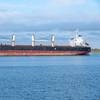Young Brothers, Ltd.'s tug, the Hoku Ke'a, has returned to service after being fitted with Nautican Research and Development Ltd.'s new Integrated Nozzle and Rudder Units at Foss Shipyards in Seattle. Mark Houghton, Vice-President, Maritime Operations, of Hawaiian Tug & Barge, Young Brothers reports that on the return trip to Hawaii, "the Hoku Ke'a was able to run at reduced r.p.m. and still averaged between 9.5 and 10 knots for the Pacific transit, towing a 340 x 78 ft. barge." This is the first installation of the Nautican Integrated Units on an ocean-going tug.
Prior to the conversion, the Hoku Ke'a was fitted with conventional open propellers and rudders. The 108 x 34 ft., 3,900 hp tug's bollard pull went from 88,853 lbs with open propellers to 132,810 lbs with the Nautican Nozzles. Houghton said, "Young Brothers considers the increase in bollard pull of approximately 50 percent, with fuel conservation and increase in towing speed to be a better economic business case than repowering the same tug for equivalent performance. The triple-aspect rudders reinstate, if not improve, the vessel responsiveness by providing additional steering surface area in the aperture created by the Nautican nozzles." Joe Gruzling, president of Nautican Research and Development Ltd., adds, "the thrust increase is 10 to 12 percent more than what any Kort nozzle will do at bollard, and at towing speed the increase will be even more."
"With the higher bollard pulling power, the tug will be able to conduct tandem tows and still maintain required delivery schedules for our customers. Additionally Young Brothers has chartered larger barges, which the Hoku Ke'a will now be able to tow consistently in even marginal weather conditions," notes Houghton.
The results are consistent with the 2003 conversion to Nautican Nozzles of another Young Brothers tug, the Moano Holo. The 120 x 34 ft. 3,000 hp Moano Holo's bollard pull increased 58 percent, from 64,000 lbs to 101,500 lbs after the conversion from open propellers to 108 in. Nautican Nozzles. Houghton said, "We have proven the Nautican conversion on the Young Brothers tug Moano Holo is a cost efficient performance enhancement, that pays for itself in a short period of years. This type of cost-performance ratio provides the company with a competitive advantage."
The purpose of the Nautican Integrated Units is to save installation time in the shipyard. In this refit, each Integrated Unit consists of a 112-in. Nautican High Efficiency Nozzle and a set of High Efficiency Triple Rudders. A pre-swirl stator can sometimes be included, "but it is a more practical option for new installations," explains Gruzling. Dave Palmer, estimator/project manager with Foss Shipyards says, "Although it's the first time [for us] with this installation design, I think it went much smoother and I feel there has been some increase in the installation efficiency," as compared to the Moano Holo. He adds, "the effort for the alignment of the rudders was much less," on the Hoku Ke'a as an example of the increased installation efficiency. But he notes, "it is difficult to put an exact figure on the improvement because the vessels have a number of differences from their structural configuration to their internal interferences."
Gruzling explains that, "because half the installation time is for installing and aligning the rudders, using the Integrated Units could potentially reduce the installation time by 50 percent." He adds, "there is also less chance of making installation errors, because the yard doesn't have to align each of the stators, nozzles, propellers, and rudders."
"We are looking forward to monitoring the Hoku Ke'a performance as she tows Young Brothers loaded barges between Honolulu and neighbor island ports. We expect to document faster transit times with commensurate fuel savings," says Houghton. He adds, "we hope the Integrated Units will prove to be relatively maintenance free between scheduled dry dockings."
Subscribe for
Maritime Reporter E-News
Maritime Reporter E-News is the maritime industry's largest circulation and most authoritative ENews Service, delivered to your Email five times per week










